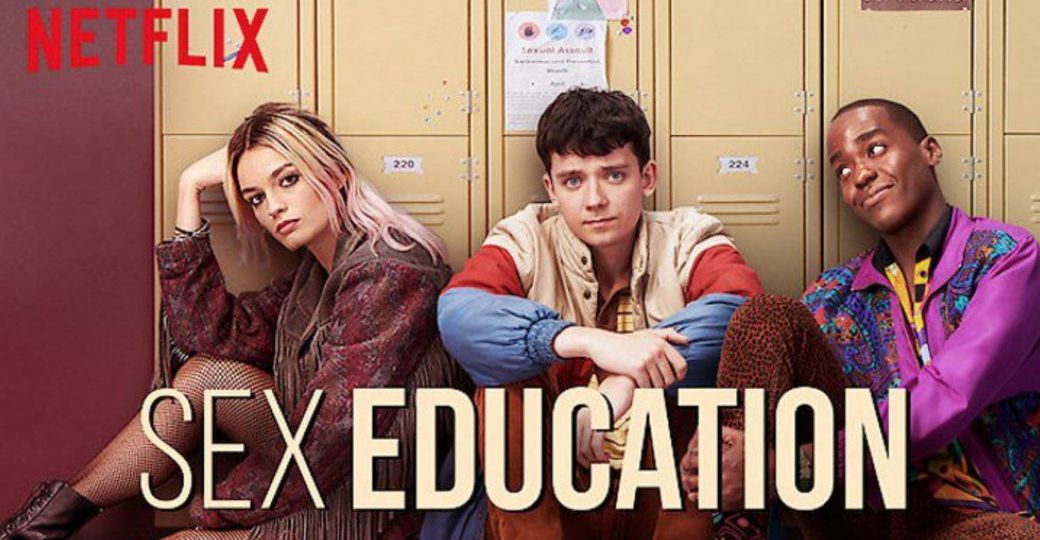
I finally got around to watching Laurie Nunn’s debut series Sex Education that premiered in 2019 on Netflix. With its unflinchingly honest narrative and bold character depictions, the show dives deep into the lives of young teenagers as they navigate their struggles in high school, explore themselves as sexual beings and come to terms with their identities. It features Asa Butterfield as the protagonist Otis Milburn who although inexperienced, starts a peer counselling service with his friend (played by the brilliant Emma Mackey), and helps out his classmates on many issues ranging from pleasure, desires, and orientation, to healthy relationships, sexual health, and contraception. As opposed to the familiar story format, which focuses on platitudes and a linear structure, Sex Education expands the scope of the plot and brings in multiple characters, complicating and presenting an empathic take on issues such as transphobia, sexuality education and abortion.
Scenes that did not shy away from talking about painful sex or depictions of realistic masturbation or the one where Gillian Anderson’s character (a sex therapist) reassured a young student trying to understand their sexuality, made me reflect on my experiences as a young student in an Indian school where conversations around sex were unimportant. Our teachers struggled to deliver lectures on the reproductive health system. Such chapters were slyly brushed off by them as being content that we “already know” because we were living in the “Internet era”. As my peers and I traversed this confusing time, we confided in each other and talked about our desires, bodily changes and relationships. However imperfect these conversations were (much like Otis and his therapy sessions), they did provide me a sense of confidence and support. At that moment I did not feel alone. I could relate to their stories, confusions and hesitations.
Comprehensive sexuality education in India is fraught with challenges. There is a moral connotation attached to sexuality, and the idea that increased knowledge among young people is dangerous, wrong and will spoil them. Social and cultural norms, behaviours and attitudes act to limit young people’s sexual agency, and their access to accurate information and services related to sexual and reproductive health and rights. Protectionist approaches to sexuality further prevent young people, particularly young women and girls from learning about their bodies, health and rights. I distinctly remember conversations with young girls in Himachal Pradesh and Uttar Pradesh (during the time I interned with an NGO there), wherein they told me that they had never seen their bodies in the mirror or that they would crouch while taking a bath so that their bodies were not visible even to themselves. Such habits, though small, are not uncommon and have a huge impact on the way we see ourselves. As a society, we have not been able to shred the uneasiness with our bodies. Perhaps that is why, the biology teachers or counsellors in my school found it difficult to say sex, vagina, clitoris and penis out loud. Imagine the horror, if my school hired someone like Gillian Anderson’s character, Dr. Jean Milburn, to talk about sexuality!
Because conversations around sexuality are so limited and mostly revolve around violence and objectification of bodies, young people are not able to adequately make sense of their emotions and desires, to understand what consent is, and to develop affirming social and sexual relationships. The Indian education system rarely provides a safe and sexuality-affirming space to talk about these issues, and when they do, the discussions are often perfunctory and follow the dominant heteronormative discourse. We see such a limited understanding of gender and its diverse expressions play out in the ways marginalised communities are excluded and face harassment, discrimination, violence or the restrictive ways in which policies and laws are formulated. The recently passed Transgender (Protection of Rights) Act in India for example, systemically ignores the basic rights of a transgender person, their choices and autonomy and puts in place arbitrary mechanisms, giving the government the authority to control their lives.
We need a holistic approach to sexuality education, one which is positive, inclusive, takes multiple contexts and realities into account and is empowering. This would equip young people to challenge patriarchal structures, make informed decisions and lead happy lives. While Sex Education is contextually very different, there are lessons that one can take from it, the most critical being the need to centre young people’s voices in conversations and decision-making processes. As the series progresses, we see the young characters understand their fears and anxieties and ask critical questions from their peers and teachers. It was particularly interesting to see a young student ask their teacher about gay people’s pleasure during a sexuality education class and to view a confused classmate seek help from Otis about sexual intercourse.
It is clear that to realise young people’s right to accurate comprehensive sexuality education, we need to ensure that in addition to strengthening peer education, young people actively participate and have a say in the formulation of the sexuality education curriculum.
Cover Image: Netflix